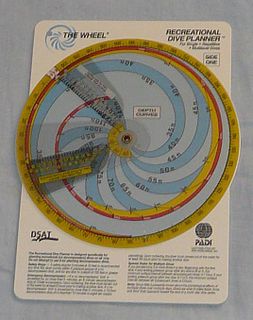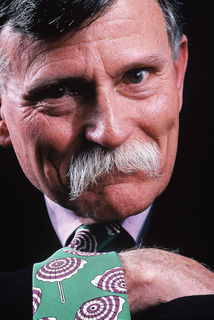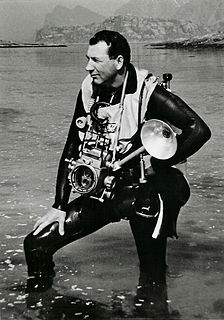Related Research Articles
Nitrox refers to any gas mixture composed of nitrogen and oxygen. This includes atmospheric air, which is approximately 78% nitrogen, 21% oxygen, and 1% other gases, primarily argon. In the usual application, underwater diving, nitrox is normally distinguished from air and handled differently. The most common use of nitrox mixtures containing oxygen in higher proportions than atmospheric air is in scuba diving, where the reduced partial pressure of nitrogen is advantageous in reducing nitrogen uptake in the body's tissues, thereby extending the practicable underwater dive time by reducing the decompression requirement, or reducing the risk of decompression sickness.

Trimix is a breathing gas consisting of oxygen, helium and nitrogen and is used in deep commercial diving, during the deep phase of dives carried out using technical diving techniques, and in advanced recreational diving.

The Professional Association of Diving Instructors (PADI) is a recreational diving membership and diver training organization founded in 1966 by John Cronin and Ralph Erickson. Cronin was originally a NAUI instructor who decided to form his own organization with Erickson, and to break diver training down into several modular courses instead of the single universal course then prevalent.

Technical diving is scuba diving that exceeds the agency-specified limits of recreational diving for non-professional purposes. Technical diving may expose the diver to hazards beyond those normally associated with recreational diving, and to a greater risk of serious injury or death. The risk may be reduced by appropriate skills, knowledge and experience, and by using suitable equipment and procedures. The skills may be developed through appropriate specialised training and experience. The equipment often involves breathing gases other than air or standard nitrox mixtures, and multiple gas sources.

Deep diving is underwater diving to a depth beyond the norm accepted by the associated community. In some cases this is a prescribed limit established by an authority, while in others it is associated with a level of certification or training, and it may vary depending on whether the diving is recreational, technical or commercial. Nitrogen narcosis becomes a hazard below 30 metres (98 ft) and hypoxic breathing gas is required below 60 metres (200 ft) to lessen the risk of oxygen toxicity.

Altitude diving is underwater diving using scuba or surface supplied diving equipment where the surface is 300 metres (980 ft) or more above sea level. Altitude is significant in diving because it affects the decompression requirement for a dive, so that the stop depths and decompression times used for dives at altitude are different from those used for the same dive profile at sea level. The U.S. Navy tables recommend that no alteration be made for dives at altitudes lower than 91 metres (299 ft) and for dives between 91 and 300 meters correction is required for dives deeper than 44 metres (144 ft) of sea water. Most recently manufactured decompression computers can automatically compensate for altitude.

A dive computer, personal decompression computer or decompression meter is a device used by an underwater diver to measure the elapsed time and depth during a dive and use this data to calculate and display an ascent profile which according to the programmed decompression algorithm, will give a low risk of decompression sickness.
In underwater diving activities such as saturation diving, technical diving and nitrox diving, the maximum operating depth (MOD) of a breathing gas is the depth below which the partial pressure of oxygen (pO2) of the gas mix exceeds an acceptable limit. This limit is based on risk of central nervous system oxygen toxicity, and is somewhat arbitrary, and varies depending on the diver training agency or Code of Practice, the level of underwater exertion expected and the planned duration of the dive, but is normally in the range of 1.2 to 1.6 bar.

Scuba diving is a mode of underwater diving whereby divers use breathing equipment that is completely independent of a surface air supply. The name "scuba", an acronym for "Self-Contained Underwater Breathing Apparatus", was coined by Christian J. Lambertsen in a patent submitted in 1952. Scuba divers carry their own source of breathing gas, usually compressed air, affording them greater independence and movement than surface-supplied divers, and more time underwater than free divers. Although the use of compressed air is common, a gas blend with a higher oxygen content, known as enriched air or nitrox, has become popular due to the reduced nitrogen intake during long and/or repetitive dives. Also, breathing gas diluted with helium may be used to reduce the likelihood and effects of nitrogen narcosis during deeper dives.

Underwater diving, as a human activity, is the practice of descending below the water's surface to interact with the environment. It is also often referred to as diving, an ambiguous term with several possible meanings, depending on context. Immersion in water and exposure to high ambient pressure have physiological effects that limit the depths and duration possible in ambient pressure diving. Humans are not physiologically and anatomically well adapted to the environmental conditions of diving, and various equipment has been developed to extend the depth and duration of human dives, and allow different types of work to be done.

The Recreational Dive Planner is a decompression table in which no-stop time underwater is calculated. The RDP was developed by DSAT and was the first dive table developed exclusively for no-stop recreational diving. There are four types of RDPs: the original table version first introduced in 1988 along with a circular slide rule version called The Wheel, followed by the eRDP, an electronic version introduced in 2005 and the eRDPML, an electronic multi-level version introduced in 2008.
Rubicon Foundation, Inc. is a non-profit organization devoted to contributing to the interdependent dynamic between research, exploration, science and education. The foundation, started in 2002, is located in Durham, North Carolina and is primarily supported by donations and grants. Funding has included the Office of Naval Research from 2008 to 2010. Gibson, Dunn & Crutcher has provided pro bono services to assist in copyright searches and support.

A dive profile is a description of a diver's pressure exposure over time. It may be as simple as just a depth and time pair, as in: "sixty for twenty," or as complex as a second by second graphical representation of depth and time recorded by a personal dive computer. Several common types of dive profile are specifically named, and these may be characteristic of the purpose of the dive. For example, a working dive at a limited location will often follow a constant depth (square) profile, and a recreational dive is likely to follow a multilevel profile, as the divers start deep and work their way up a reef to get the most out of the available breathing gas. The names are usually descriptive of the graphic appearance.

The decompression of a diver is the reduction in ambient pressure experienced during ascent from depth. It is also the process of elimination of dissolved inert gases from the diver's body, which occurs during the ascent, largely during pauses in the ascent known as decompression stops, and after surfacing, until the gas concentrations reach equilibrium. Divers breathing gas at ambient pressure need to ascend at a rate determined by their exposure to pressure and the breathing gas in use. A diver who only breathes gas at atmospheric pressure when free-diving or snorkelling will not usually need to decompress, Divers using an atmospheric diving suit do not need to decompress as they are never exposed to high ambient pressure.

A diving instructor is a person who trains and usually also assesses competence of underwater divers. This includes freedivers, recreational divers including the subcategory technical divers, and professional divers which includes military, commercial, public safety and scientific divers.

Robert William Hamilton Jr., known as Bill, was an American physiologist known for his work in hyperbaric physiology.

Neal Pollock is a Canadian academic and diver. Born in Edmonton, Canada he completed a bachelor's degree in zoology; the first three years at University of Alberta and the final year at the University of British Columbia. After completing a master's degree he then served as diving officer at University of British Columbia for almost five years. He then moved to Florida and completed a doctorate in exercise physiology/environmental physiology at Florida State University.

There are several categories of decompression equipment used to help divers decompress, which is the process required to allow divers to return to the surface safely after spending time underwater at higher ambient pressures.

The history of scuba diving is closely linked with the history of the equipment. By the turn of the twentieth century, two basic architectures for underwater breathing apparatus had been pioneered; open-circuit surface supplied equipment where the diver's exhaled gas is vented directly into the water, and closed-circuit breathing apparatus where the diver's carbon dioxide is filtered from the exhaled breathing gas, which is then recirculated, and more gas added to replenish the oxygen content. Closed circuit equipment was more easily adapted to scuba in the absence of reliable, portable, and economical high pressure gas storage vessels. By the mid-twentieth century, high pressure cylinders were available and two systems for scuba had emerged: open-circuit scuba where the diver's exhaled breath is vented directly into the water, and closed-circuit scuba where the carbon dioxide is removed from the diver's exhaled breath which has oxygen added and is recirculated. Oxygen rebreathers are severely depth limited due to oxygen toxicity risk, which increases with depth, and the available systems for mixed gas rebreathers were fairly bulky and designed for use with diving helmets. The first commercially practical scuba rebreather was designed and built by the diving engineer Henry Fleuss in 1878, while working for Siebe Gorman in London. His self contained breathing apparatus consisted of a rubber mask connected to a breathing bag, with an estimated 50–60% oxygen supplied from a copper tank and carbon dioxide scrubbed by passing it through a bundle of rope yarn soaked in a solution of caustic potash. During the 1930s and all through World War II, the British, Italians and Germans developed and extensively used oxygen rebreathers to equip the first frogmen. In the U.S. Major Christian J. Lambertsen invented a free-swimming oxygen rebreather. In 1952 he patented a modification of his apparatus, this time named SCUBA, an acronym for "self-contained underwater breathing apparatus," which became the generic English word for autonomous breathing equipment for diving, and later for the activity using the equipment. After World War II, military frogmen continued to use rebreathers since they do not make bubbles which would give away the presence of the divers. The high percentage of oxygen used by these early rebreather systems limited the depth at which they could be used due to the risk of convulsions caused by acute oxygen toxicity.
References
- ↑ "Company Overview of PADI Worldwide Corp". Bloomberg Businessweek. Retrieved 25 May 2014.
- ↑ Hamilton Jr RW, Rogers RE, Powell MR (1994). "Development and validation of no-stop decompression procedures for recreational diving: the DSAT recreational dive planner". Tarrytown, NY: Diving Science & Technology Corp. Archived from the original on August 7, 2009. Retrieved 2008-06-16.
{{cite journal}}: Cite journal requires|journal=(help)CS1 maint: unfit URL (link) - ↑ DSAT, ed. (1979). "Decompression in Depth". Diving Science and Technology Workshop. Archived from the original on August 20, 2008. Retrieved 2008-08-20.
{{cite journal}}: CS1 maint: unfit URL (link) - ↑ Graver, D, ed. (1980). "Physiology in Depth". Diving Science and Technology Workshop. Archived from the original on August 20, 2008. Retrieved 2008-08-20.
{{cite journal}}: CS1 maint: unfit URL (link) - ↑ Richardson, D; Menduno, M; Shreeves, K, eds. (1996). "Proceedings of Rebreather Forum 2.0". Diving Science and Technology Workshop.: 286. Archived from the original on September 15, 2008. Retrieved 2008-08-20.
{{cite journal}}: CS1 maint: unfit URL (link)